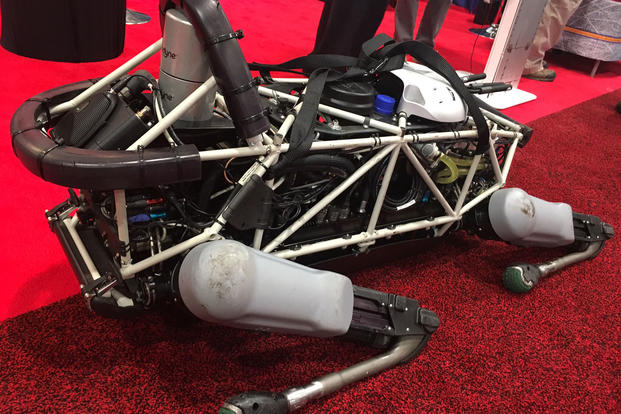NATIONAL HARBOR, Maryland -- After a long hiatus, the Marine Corps is about to start experimenting again with one of its most fanciful concepts.
Officials with the Marine Corps Warfighting Lab told Military.com that Spot, the Corps' four-legged robot, will enter developmental testing this fall focused on the possibilities of manned-unmanned teaming with ground troops.
The dog-sized robot's hydraulic legs may prove more maneuverable than the Modular Advanced Armed Robotic System, a small unmanned system with tank-like treads that has also been tested at the Warfighting Lab, said Capt. Mike Malandra, the lab's ground branch head for science and technology.
"It's not a tracked vehicle so it can turn around on a dime. The other benefit of something like that is it can get up when it falls over, whereas MAARS can't," Malandra said. "So that's really what we're looking at doing, potentially, with those kinds of things moving forward here in fall: Use it as a surrogate platform for something that is maneuverable in a way similar to a human."
The Corps has had a long flirtation with the idea of incorporating four-legged robots into infantry operations.
A $32 million Defense Advanced Research Projects Agency program was launched in collaboration with the Marine Corps in 2010 to test the potential of the Legged Squad Support System, a hulking robotic pack animal known more affectionately as the robo-mule. Made by Google Inc.'s Boston Dynamics, the LS3 was trotted out in front of then-commandant Gen. Jim Amos in 2012 and featured prominently alongside Marines in the massive Rim of the Pacific exercise in 2014.
But as Military.com reported in late 2015, the experimental program ultimately came to an end without a commitment from the Corps to develop the concept further. Among issues cited: the robot's noisy diesel engine, which would be a liability on patrols, and the logistical challenge of fixing the system if it broke.
Spot, a much smaller battery-powered robot also made by Boston Dynamics, was bequeathed to the service after the experiment ended and has sat in the kennel ever since, Malandra said.
"It's been pretty dormant," he said. "It's been a showpiece, really."
But the recently released Marine Corps Operating Concept, which highlights the significance of Marine-robot teaming in future conflicts, may create new opportunities for Spot to show off his tricks. Two of the little robots were delivered to the service Monday after spending months at Boston Dynamics getting strategic upgrades.
Now, the system features a radio and a 180-degree camera in the nose, as well as Teleop-assist logic, which will keep Spot from crashing into physical obstacles, even if the human operator directs it to do so.
Malandra said developmental testing this fall will set the stage for a limited technical assessment in 2018. The ultimate goal, he said, is to develop requirements for an unmanned partner that can assist a Marine in the field, whether with patrolling, reconnaissance or other ground warfare capabilities.
"We're looking to put them in environments and lanes that are similar to things we've come up with through wargaming and through other things, that fit our operational concept that was just published for 2025," Malandra said.
"To be able to put them in lanes where we can evaluate metrics such as lethality and tempo, which are very fluid, and what they actually mean," he said. "So how do we quantify that, how do we create a baseline ... to evaluate whether or not a system that can provide autonomous tasking is beneficial or not."
-- Hope Hodge Seck can be reached at hope.seck@military.com. Follow her on Twitter at@HopeSeck.




























